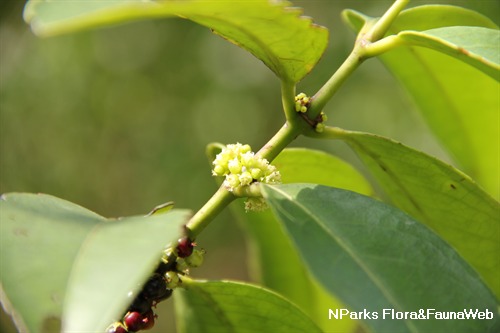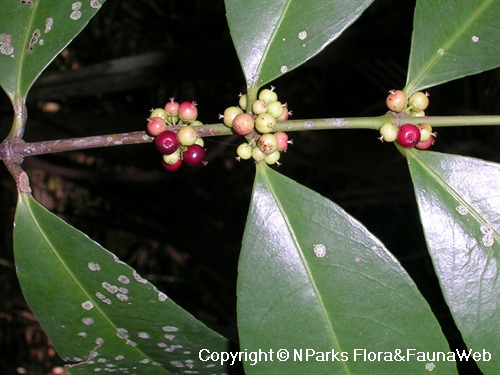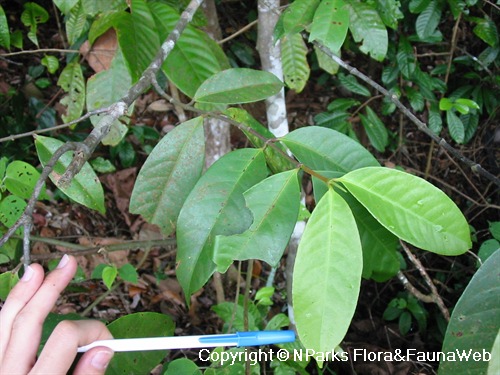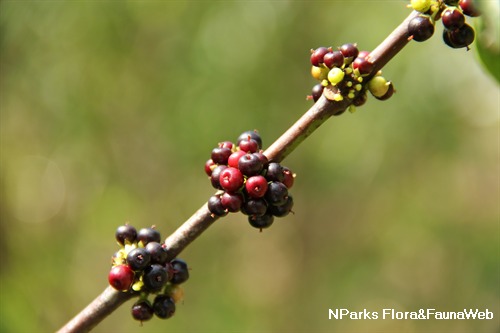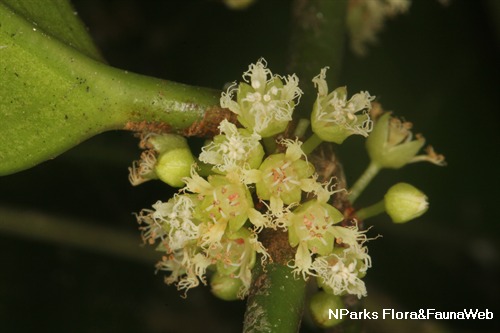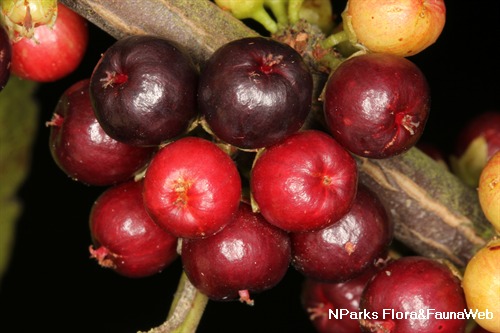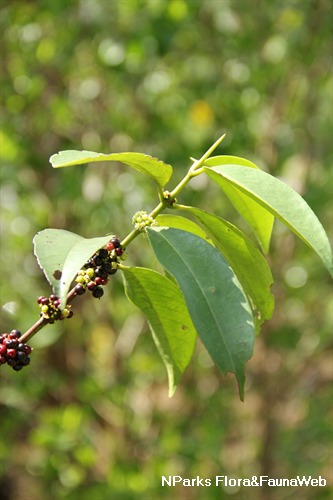
Back
Gynotroches axillaris Blume
| Family Name: | Rhizophoraceae |
| Common Name: | Mata Keli, Fish Eyes, Bulu Bulu, Pianggu Jantan |
Name
Classifications and Characteristics
| Plant Division | Angiosperms (Flowering Seed Plants) (Dicotyledon) |
|---|---|
| Plant Growth Form | Tree (Big (>30m)) |
| Lifespan (in Singapore) | Perennial |
| Mode of Nutrition | Autotrophic |
| Plant Shape | Irregular |
| Maximum Height | 45 m |
Biogeography
| Native Distribution | South Myanmar, south Thailand, Malaysia, Brunei, Indonesia to Australia, Micronesia, and Melanesia |
|---|---|
| Native Habitat | Terrestrial (Primary Rainforest, Mountain, Secondary Rainforest, Freshwater Swamp Forest, Riverine, Disturbed Area / Open Ground) |
| Preferred Climate Zone | Tropical |
| Local Conservation Status | Native to Singapore (Least Concern (LC)) |
Description and Ethnobotany
| Growth Form | It is a tree up to 45 m tall. |
|---|---|
| Foliage | Its opposite, shortly-stalked leaves have pairs of leaves rotated perpendicular to each other (decussate arrangement), and leaf blades that are shiny dark green above, yellowish beneath, and 4.5–20 by 1.5–9 cm, with distinct veins. |
| Flowers | Its tiny flowers are greenish-white, and about 6 mm wide. |
| Fruit | Its many-seeded, round berries are red to a shiny black colour when ripe, and about 3 mm wide. Its round seeds are 1.5 by 0.5 mm. |
| Habitat | It grows in marshy places, swamps, along creeks or rivers in forests, montane forests, secondary forests, and slopes of partially open forests, from lowlands to 2,250 m altitude. It also grows on sandy, well-drained soils. |
| Associated Fauna | Its small red fruits are eaten by forest birds. |
| Cultivation | It can be propagated from seed. |
| Ethnobotanical Uses | Medicinal: The leaves may be applied as a poultice for the head for fever. Timber & Products: The wood is occasionally used for indoor construction for house-posts, and rafters, and as oar blades. |
Landscaping Features
| Landscaping | The plant is attractive with its neat foliage, and red to black fruits. It has prop roots, and it can be grown semi-submerged in or around ponds. |
|---|---|
| Desirable Plant Features | Ornamental Fruits, Ornamental Form |
| Landscape Uses | Parks & Gardens, Riverine, Pond / Lake / River, Marsh / Bog |
Fauna, Pollination and Dispersal
| Fauna Pollination Dispersal Associated Fauna | Bird-Attracting |
|---|---|
| Pollination Method(s) | Biotic (Fauna) |
| Seed or Spore Dispersal | Biotic (Fauna) |
Plant Care and Propagation
| Light Preference | Full Sun, Semi-Shade |
|---|---|
| Water Preference | Moderate Water, Lots of Water |
| Plant Growth Rate | Moderate |
| Rootzone Tolerance | Moist Soils, Waterlogged Soils (Drains Site, Does not Drain Site), Well-Drained Soils, Fertile Loamy Soils |
| Propagation Method | Seed |
Foliar
| Foliage Retention | Evergreen |
|---|---|
| Mature Foliage Colour(s) | Green |
| Mature Foliage Texture(s) | Leathery |
| Foliar Type | Simple / Unifoliate |
| Foliar Arrangement Along Stem | Opposite |
| Foliar Attachment to Stem | Petiolate |
| Foliar Shape(s) | Non-Palm Foliage (Oval, Elliptical) |
| Foliar Venation | Pinnate / Net |
| Leaf Area Index (LAI) for Green Plot Ratio | 3.0 (Tree - Intermediate Canopy) |
Floral (Angiosperm)
| Flower & Plant Sexuality | Bisexual Flowers |
| Flower Colour(s) | Green - Light Green, White |
|---|---|
| Flower Grouping | Cluster / Inflorescence |
| Flower Location | Axillary |
| Flower Symmetry | Radial |
Fruit, Seed and Spore
| Mature Fruit Colour(s) | Red, Purple, Black |
|---|---|
| Fruit Classification | Simple Fruit |
| Fruit Type | Fleshy Fruit , Non-Accessory Fruit |
Image Repository
Others
| Master ID | 1657 |
|---|---|
| Species ID | 2950 |
| Flora Disclaimer | The information in this website has been compiled from reliable sources, such as reference works on medicinal plants. It is not a substitute for medical advice or treatment and NParks does not purport to provide any medical advice. Readers should always consult his/her physician before using or consuming a plant for medicinal purposes. |

